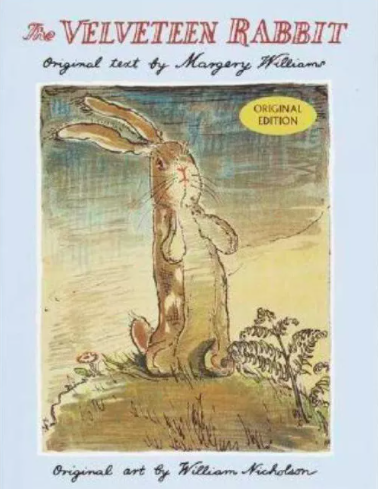The Velveteen Rabbit
Book Module Navigation
Summary
A tale of a forgotten toy rabbit that encourages discussion of reality, and whether there are different levels of reality.
The Velveteen Rabbit lives in the Boy’s nursery with all the other toys, waiting for the day when the Boy will choose him as a playmate. In time, the shy Rabbit befriends the tattered Skin Horse, the wisest resident of the nursery, who reveals the goal of all nursery toys: to be made “real” through the love of a human. “‘Real isn’t how you are made,’ said the Skin Horse. ‘It’s a thing that happens to you. When a child loves you for a long, long time, not just to play with, but REALLY loves you, then you become Real.'”
Read aloud video by Texas Gal Treasures
Guidelines for Philosophical Discussion
What exactly makes something real? A child is given a gift of a stuffed rabbit at Christmas. The story is told from the point of view of the toy. The rabbit is told that if he is loved enough he will become real. When the child falls ill the toy is to be thrown away, but is given a new life, and a new view of reality. There are several possible definitions of reality given in The Velveteen Rabbit. The velveteen rabbit is an object that can be touched and seen and played with, and therefore it is real in a physical sense. The second is that something can become real when it is loved enough. The third and final definition of reality in the story is when the toy becomes a flesh and blood rabbit. The main focus of the discussion should not only be on what is real and unreal, but also upon whether there are different layers of reality.
Questions for Philosophical Discussion
How many of you have imaginary friends or toys that you thought were real?
- Why did you think they were real?
- What made them real?
- Why did you stop thinking they were real?
“The mechanical toys, like the model train, were very stuck-up and boasted that they were real. But the Rabbit could not claim to be a model of anything, for he didn’t know that real rabbits existed…”
- Why did the model trains think they were real?
- If you think of something that does not exist, does that mean it is not real?
- If something exists, but you don’t know about it, does that mean it is not real? Why?
- When in the story does the Rabbit become real?
- Is the Rabbit real from the very beginning? Why?
The other rabbits tell the Velveteen Rabbit that he isn’t real, but the little boy said the Rabbit was real.
- Was the little boy wrong?
- Were the rabbits wrong?
- Were either of them right? Why?
The rabbits tell the Velveteen Rabbit that he isn’t real because he doesn’t do things real rabbits do. He doesn’t smell right, he doesn’t have hind legs, and he doesn’t dance the way they do. However, the Rabbit does do things that we may call real behaviors, such as crying, breathing, and having emotions.
- Is one set of behaviors more real than another?
- If you had one and not the other would that make you less or more real?
- “‘What is REAL?’ asked the Rabbit one day. Does it mean having things that buzz inside you and a stick-out handle?’”
- What is real?
- Can you be made ‘real’ like the Rabbit?
- What makes you real?
Original questions and guidelines for philosophical discussion by Alison Coates. Edited May 2020 by The Janet Prindle Institute for Ethics.
Find tips for leading a philosophical discussion on our Resources page.






